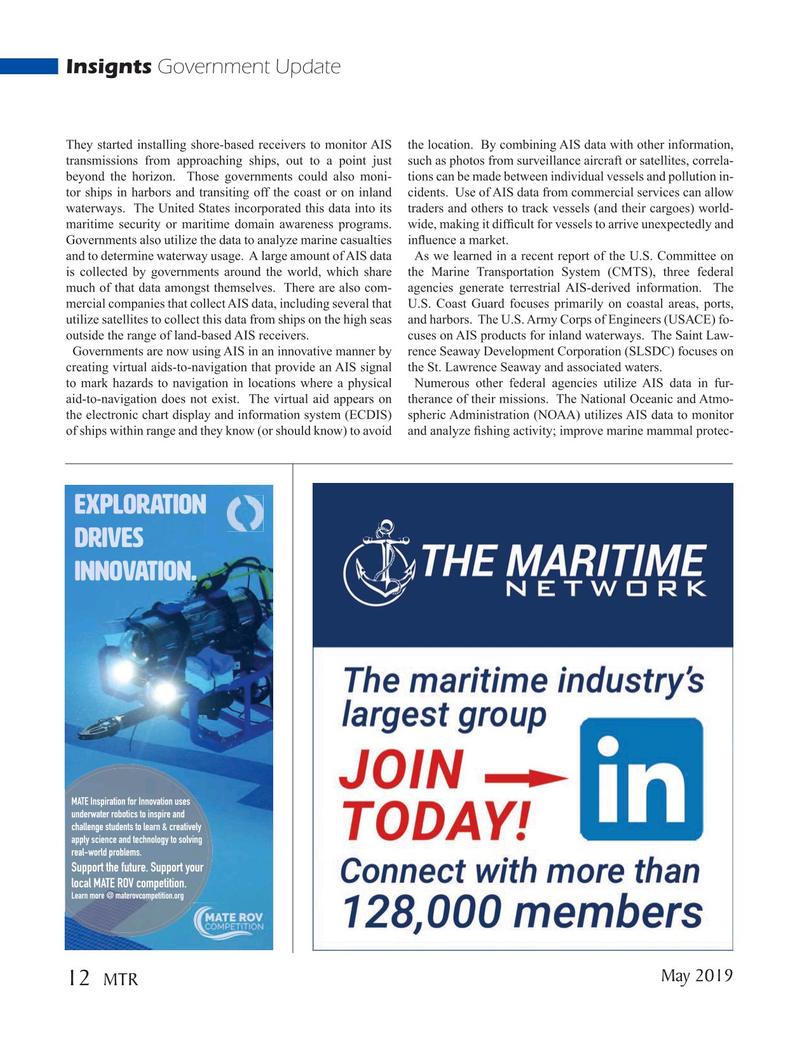
Page 12: of Marine Technology Magazine (May 2019)
Underwater Defense Technology
Read this page in Pdf, Flash or Html5 edition of May 2019 Marine Technology Magazine
Insignts Government Update
They started installing shore-based receivers to monitor AIS the location. By combining AIS data with other information, transmissions from approaching ships, out to a point just such as photos from surveillance aircraft or satellites, correla- beyond the horizon. Those governments could also moni- tions can be made between individual vessels and pollution in- tor ships in harbors and transiting off the coast or on inland cidents. Use of AIS data from commercial services can allow waterways. The United States incorporated this data into its traders and others to track vessels (and their cargoes) world- maritime security or maritime domain awareness programs. wide, making it dif? cult for vessels to arrive unexpectedly and
Governments also utilize the data to analyze marine casualties in? uence a market.
and to determine waterway usage. A large amount of AIS data As we learned in a recent report of the U.S. Committee on is collected by governments around the world, which share the Marine Transportation System (CMTS), three federal much of that data amongst themselves. There are also com- agencies generate terrestrial AIS-derived information. The mercial companies that collect AIS data, including several that U.S. Coast Guard focuses primarily on coastal areas, ports, utilize satellites to collect this data from ships on the high seas and harbors. The U.S. Army Corps of Engineers (USACE) fo- outside the range of land-based AIS receivers. cuses on AIS products for inland waterways. The Saint Law-
Governments are now using AIS in an innovative manner by rence Seaway Development Corporation (SLSDC) focuses on creating virtual aids-to-navigation that provide an AIS signal the St. Lawrence Seaway and associated waters.
to mark hazards to navigation in locations where a physical Numerous other federal agencies utilize AIS data in fur- aid-to-navigation does not exist. The virtual aid appears on therance of their missions. The National Oceanic and Atmo- the electronic chart display and information system (ECDIS) spheric Administration (NOAA) utilizes AIS data to monitor of ships within range and they know (or should know) to avoid and analyze ? shing activity; improve marine mammal protec-
Exploration drives innovation. . . . . . . . .
MATE Inspiration for Innovation uses underwater robotics to inspire and challenge students to learn & creatively apply science and technology to solving real-world problems.
Support the future. Support your local MATE ROV competition.
Learn more @ materovcompetition.org May 2019 12
MTR
MTR #4 (1-17).indd 12 4/25/2019 9:12:07 AM

 11
11

 13
13
